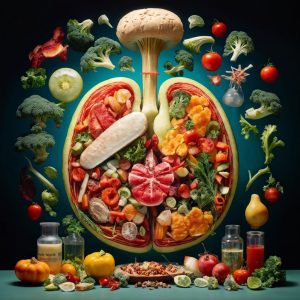The plant-based protein industry is growing fast, driven by increasing concerns over sustainability, health, and animal welfare. What’s fascinating is how new technologies like artificial intelligence (AI), fermentation, and upcycling are completely reshaping the way we think about food. These innovations are setting the stage for more sustainable, efficient, and nutritious alternatives to traditional animal proteins. But as with any new development, there are both benefits and disadvantages. Let’s look at how these trends are redefining the future of food—and what it means for consumers and the environment.
What role does AI have in Plant-based Proteins?
Artificial intelligence is being used to develop food especially, plant-based proteins where the ultimate goal is to produce better-tasting food, which is healthier and, and at the same time is more eco-friendly. With AI, companies can analyze huge amounts of data quickly, identifying which ingredients work best together to create the ideal texture and flavor. This technology also helps to improve the nutritional content of plant-based products.
According to PWC, AI could contribute up to $15.7 trillion to the global economy by 2030, especially in regard to food production. For example, companies are using AI to fine-tune recipes so that plant-based proteins can more closely mimic the taste and texture of meat or dairy. This is important because one of the main barriers to the wider adoption of plant-based proteins is the perception that they don’t taste as good as their animal-based counterparts. By leveraging AI, companies can better meet consumer demands for healthier, tastier, and more sustainable foods.
However, the danger of relying on AI may lead to overly processed foods. Critics argue that AI-driven food innovations could create products that are more “engineered” than natural, sparking concerns about transparency in food production. Some consumers may worry that these high-tech foods are straying too far from traditional, natural methods.
What is Fermentation in Protein Innovation?
Fermentation is a time-tested method used in food production, but it’s now being used in groundbreaking ways to create plant-based proteins. Through this process companies can use microbes to produce proteins that are molecularly identical to those found in animal products. For example, Perfect Day uses fermentation to create proteins identical to cow’s milk. These proteins are then used to create dairy products like cheese and yogurt, but with a much smaller environmental footprint.
The Good Food Institute predicts that ermentation-based proteins, maybe a major player in the growing protein market, due to their abilities to reduce greenhouse gas emissions and the use of natural resources. This process also opens up new possibilities for developing ingredients that enhance the taste and texture of plant-based foods.
Despite this incredible advancement , their a a number of significant drawbacks. Firstly, the process of fermentation requires large amount of energy if used for mass production, secondly, it can be costly and may indicate the affordable of these products for consumers. Lastly, there is skeptism among consumers questioning whether these products are truly “natural.”
Upcycled Ingredients Trend
Upcycling is another key trend in the future of plant-based proteins. This process involves taking food waste—such as fruit peels, vegetable scraps, or spent grains—and turning it into something new and nutritious. This approach reduces food waste and boosts sustainability by creating new food sources from what would otherwise go to waste.
The Upcycled Food Association reports that 8% of food waste is currently upcycled into new products. This trend is expected to rise as companies adopt this process. Upcycled ingredients can also benefit global food shortages by providing additional and affordable food sources. Companies are already adopting this process, Renewable Mills, is already transforming soy milk into high protein-based flours.
Despite this, while upcycling has clear environmental benefits, consumer awareness remains low. Many people are still unfamiliar with the concept and may be hesitant to purchase products labeled as “upcycled.”
Environmental Benefits of Plant-Based Proteins
One of the biggest reasons plant-based proteins are gaining popularity is their lower environmental impact compared to meat and dairy. According to Nature, plant-based diets could reduce food-related greenhouse gas emissions by up to 70%, Plant-based foods generally require far fewer natural resources—such as land, water, and energy—than raising livestock, which makes them a more sustainable choice in the fight against climate change.
For instance, producing one kilogram of beef requires approximately 15,415 liters of water, while the same amount of lentils requires just 1,250 liters. These numbers show how much more efficient plant-based foods can be regarding resource usage. By using plant-based proteins, we can significantly reduce the environmental toll of food production.
However, not all plant-based proteins are equally sustainable. Some highly processed products, like meat substitutes, require a lot of energy to produce. Crops like soy, which is often used in plant-based foods, can also have environmental downsides, such as deforestation and soil depletion. It’s crucial to ensure that as plant-based proteins become more widespread, the production methods remain eco-friendly.
Health Benefits and Potential Risks
Health is another key factor driving interest in plant-based proteins. Research shows that diets high in plant-based foods are linked to numerous health benefits, including lower cholesterol levels, reduced risk of heart disease, and better weight management. A study from The Journal of the American Heart Association found that replacing animal proteins with plant-based alternatives can reduce the risk of cardiovascular disease by 32%.
Plant-based proteins are often lower in saturated fats and cholesterol than animal-based proteins, making them a healthier option for many people. They’re also packed with essential nutrients, such as fiber, vitamins, and minerals, which contribute to overall health.
But it’s not all positive—some plant-based products, particularly processed ones, may contain high levels of sodium, preservatives, or other additives to enhance flavor and shelf life. Consumers should be cautious about these highly processed foods and aim to incorporate more whole, minimally processed plant-based proteins into their diets. Additionally, not all plant-based proteins offer a complete amino acid profile, meaning careful meal planning is needed to ensure balanced nutrition.
Economic Impact and the Future of Plant-Based Proteins
The shift toward plant-based proteins is having a significant impact on the global economy. Bloomberg Intelligence projects the plant-based food market will reach $162 billion by 2030, fueled by consumer demand for healthier, more sustainable food options. As companies invest in new technologies and expand production, we can expect to see continued growth in the sector.
That said, the rise of plant-based proteins could disrupt traditional agriculture, particularly livestock farming, which is a major source of income for rural communities around the world. This shift may lead to job losses in the animal farming industry, although new opportunities are emerging in areas like food technology, sustainable agriculture, and research.
The challenge moving forward will be managing this economic transition while ensuring that both workers and consumers benefit from the plant-based protein boom. Investment in education, training, and infrastructure will be critical to support these changes.
in summary, The future of plant-based proteins appears to be quite promising, with cutting-edge technologies such as AI, fermentation, and upcycling driving the progress. These breakthroughs hold the potential to produce more sustainable, nourishing, and attractive substitutes for animal-based proteins, while also lessening the environmental impact of food production.






